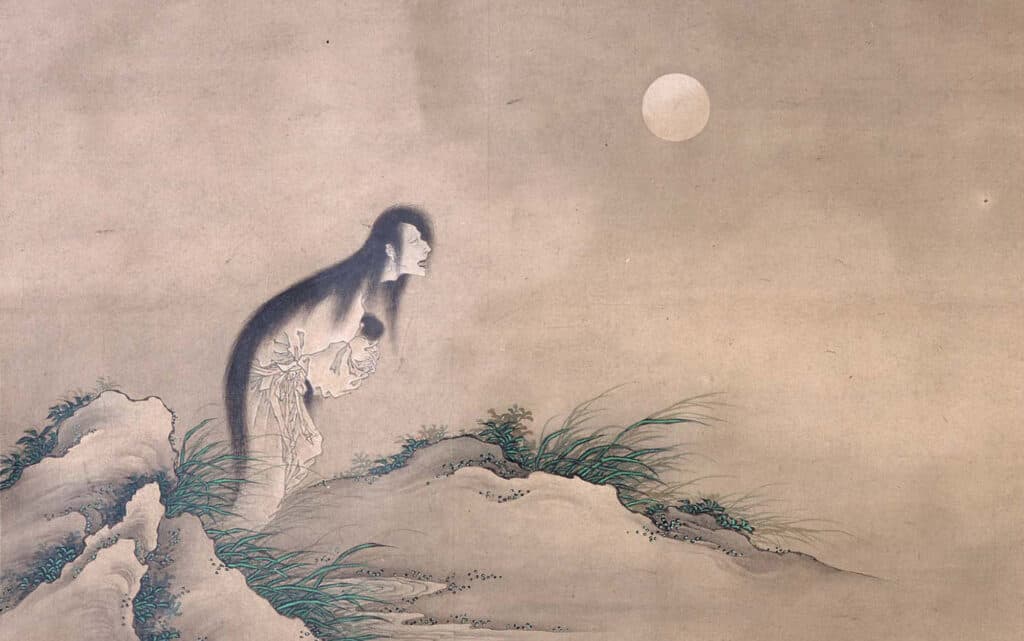The stories of Japanese ghosts and Japanese paranormal experiences fill modern-day media. Japanese paranormal stories either take the form of traditional folk tales or legends or have been adapted from folk tales to contemporary films and novels. Even modern Japanese religion integrates the supernatural into its teachings.
The bottom line is that even today, daily life in Japan is supernatural: 8 million deities (kami) are responsible for everything in daily life (even the toilet) (Iwsaka and Toelken, 1994).; Ross, 1996). Emulating old traditions, modern Japanese frequently feel that there’s little difference between the world of the living and the world of the dead. Ghosts and Hauntings are commonplace. For this reason, living people easily meet ghosts . . . and may not even realize that they have done so (Iwsaka and Toelken, 1994)!

Japanese Ghosts of the Land
There are types of Japanese Ghosts. There are, in general, two kinds of Japanese ghosts: the spirit of the living (seiryo), and the spirit of the dead (shiryo) (Iwsaka and Toelken, 1994). Spirits can be dead or alive. It doesn’t matter much.
The main distinction is that Japanese ghosts either come from komoyo (this world) or anoyo (over there). Ghosts of the dead appear out of anoyo because a ghost that should be in anoyo is tied to komoyo by strong emotions or feelings of obligation. It is, however, possible to draw the spirit into anoyo by reading special sutras, or Buddhist scriptures that release the ghost from unresolved sensations of obligation, duty, debt, honor, and personal responsibility (Iwsaka and Toelken, 1994).
As might be imagined, in the spirit of the Japanese community, feelings that involve other people are most responsible for the appearance of ghosts. Duty does not stop at death.

Because duties do not expire with the body, there are quite a few ghost stories that deal with strong feelings of obligation. (Iwsaka and Toelken, 1994). For this reason, many ghost stories related to, ongoing relationships between a dead mother and a live child or a dead child and a live mother.
Close relatives or lovers that share a sense of mutual responsibility, but are separated by death, also present possibilities for ghostly phenomena. As might be apparent, responsibility transcends death in Japanese culture.
Japanese Ghosts Are Near
Since, in Japan, the dead are near the living, the Japanese consider it wise to continue to treat the dead as if they were alive (Iwsaka and Toelken, 1994). That means that relatives still honor the dead on their birthdays, or on specific holidays. Maybe the living will continue to do maintenance on a garden that was loved by the departed. This maintenance is not a matter of stubbornly holding onto a memory; it is doing something for someone who is not able to do the work.
The departed gardener will somehow show appreciation for this polite consideration. If, however, the gardener isn’t happy with garden maintenance, in one way or another, displeasure will appear.
Japanese Obsession with Death
Does an extreme concern with death seem usual? This concern should be understood in the right spirit. In contrast to the West, Japanese ghosts serve a purpose (other than to be dead). Although the Japanese see actual physical decay as “dirty,” death, when understood in a spiritual sense, is a profound mystery that moves above and beyond decaying bodies (Iwsaka and Toelken, 1994). Japanese Ghosts are useful because they inspire emotion, more emotion than is common for the living Japanese.
Japanese ghosts make debts, obligations, and guilt very real and very obvious. That’s because they don’t hide behind polite gentility. In addition, ghosts frequently serve as reminders of duties that must be done or appear as helpful guides that impart vital information to the living. More importantly, ghosts give the living (and the dead) freedom to express intense emotions that are normally repressed in Japanese society. In some respects, ghosts present an unearthly opportunity to confront unresolved social tensions or emotional issues that were so strongly imprinted in the living person that, to move on, this person must confront the same issues in death.
Death that results from any form of emotional stress, such as torture, betrayal, or disregard for acceptable social behavior is excellent for creating a ghost. Interestingly, Japanese ghosts are often prone to interact with the living in forms that speak and can be touched. Suspicion is that the living who see, talk, and otherwise interact with ghosts have a level of acceptance that creates the solid appearance of ghosts. Not surprisingly, perceptions and paranormal experiences of solidity occur frequently (Iwsaka and Toelken, 1994).

As is the case in most of Asia, it is important to remember that, unlike most Westerners, the Japanese both love and honor their ghosts. It’s a good place to be a ghost!
Sources
Iwsaka M. and Toelken B. (1994). Ghosts and the Japanese. Logan: Utah University Press.
Ross, C (1996). Supernatural and Mysterious Japan. Tokyo: Yen Books.